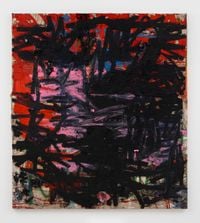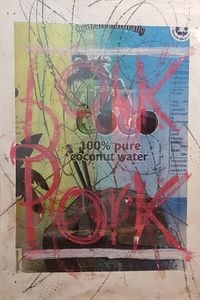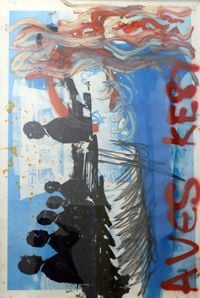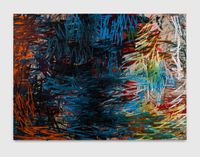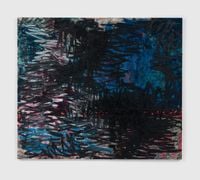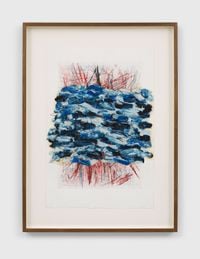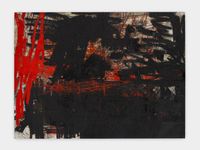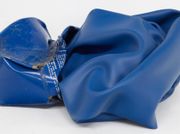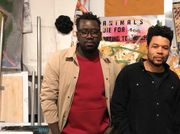Born in La Paila, Colombia, Oscar Murillo emigrated to the United Kingdom with his family as a child. He studied at the Royal College of Art in London, during which time he also worked as an office cleaner to support himself. Upon graduating in 2012, Murillo quickly developed a reputation for his stitched paintings; since then, his reputation has expanded to include drawings, sculptures, installations, films and performances, guided by the artist's fascination with the fluid concepts of identity, community and binaries.
Read MoreSewn together using old sewing machines, Murillo's stitched canvases are often covered in oil paint (applied with a broomstick) and unconventional materials including paper pulp, thread, cement dye and dust. They also frequently show traces of shoe soles and dirt from the artist working on the floor in his studio. Text also often features, including as single words such as 'chorizo', 'yoga' and 'milk', written in large letters and bright colours or black in a series of untitled paintings from 2012.
Murillo's experience as an immigrant has been a driving force in his works that explore themes of displacement and identity. meet me! Mr Superman (2013–15)—shown at his 2015 solo exhibition binary function at David Zwirner in London—is a film that follows the artist's friends in La Paila on the morning of New Year's Day. Shot from a point-of-view perspective, the film highlights the artist's disparate identities: originally born as a Columbian but now living in the United Kingdom, Murillo becomes a temporary visitor in his old hometown.
Another recurrent theme in Murillo's work is a concern with postcolonial and socioeconomic disparities. In 2016, while on his way to the 20th Biennale of Sydney Murillo flushed his British passport down the toilet as an impromptu performance that challenged the notion of privilege bestowed upon certain passports. He was detained at the airport upon arriving in Australia and, despite having his Colombian passport, was deported two days later. Murillo similarly commented on present-day colonial tendencies in international biennials through his work The Coming of the Europeans (2017), a large-scale banner across which the title is repeated, conceived for the inaugural Kathmandu Triennale in 2017.
In 2018, Murillo turned his attention to consumption and labour in Collective Conscience (2018), a large-scale installation conceived for the 10th Berlin Biennale. In the courtyard of Akademie der Künste, Murillo placed industrial ovens that baked rock-like loaves that, after they left the ovens, were sheathed inside long fabric garments. Some of the fabrics were inscribed with workers' slogans and maps of trade routes, bringing attention to the disenfranchised labourers behind the production of commodities that permeate our everyday life.
Murillo has exhibited internationally at David Zwirner, Hong Kong (2018); YARAT Contemporary Art Centre, Baku (2016); Centro Cultural Daoíz y Velarde, Madrid (2015); Showroom MAMA, Rotterdam (2013); South London Gallery (2013); and the Serpentine Gallery, London (2012), among others. At the 56th Venice Biennale (2015), the artist displayed works from his 'Frequencies' project (2013–ongoing). The project involves dispatching blank canvases to schools around the world to be completed by students between 10 and 16 years of age.
Murillo lives and works in East London.
Sherry Paik | Ocula | 2018
